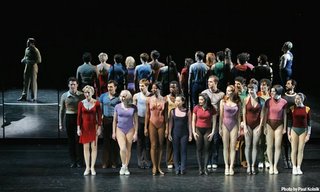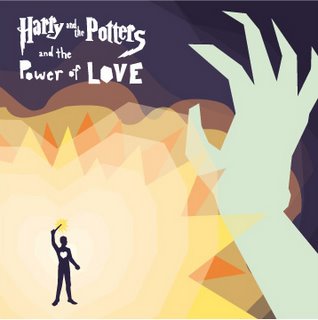Stephen Sondheim's "Company" is currently in previews at the Ethel Barrymore Theatre and will open on November 29. The original production ran from 1970 to 1972 and it had a brief revival in 1995.

Although "Company" was written in the 70s, it does not feel dated. The subject matter of a bachelor, Bobby, with married friends trying to set him up is relevant in any time period. The problems that the couples have in their relationships and the loneliness Bobby feels is also timeless. The Dolce and Gabbana suits hint that the story has been placed in the present time, but the musical does not require being grounded in a specific time. The place is slightly more important, as it would be hard to imagine the upper middle-class urbanites living anywhere but Manhattan.
As in most Sondheim shows (he wrote the music and the lyrics), there is not much of a linear storyline. The individual scenes and what they reveal about human nature are much more important than the plot.
Such a show lends itself to John Doyle's direction. Last year Doyle revived another Sondheim show, "Sweeney Todd," and had the cast double as the orchestra, which earned him critical praise as well as a Tony. This technique works just as well here, as does the minimalist set (the major set piece is a piano). The musical does not require anything but gifted actors to deliver Sondheim's thought-provoking score, which this show definitely has.
Even the most accomplished singers will probably tell you that Sondheim music, characterized by its complex changes and intricate harmonies, is not easy to perform. The 14-member cast had the added difficulty of switching between multiple instruments. Actors sang while playing the violin or moved across the stage with a double bass with relative ease. The cast is such a talented entity that it is hard to pick out a few of the performers, but it makes sense to start with Raul Esparza, who plays Bobby.
This is the show that is supposed to turn Esparza into a star, and it's about time. Broadway fans have adored him for years. Although he lucked out in that he doesn't have to play any instruments except the piano in one scene, he doesn't work any less hard. He puts everything he has into the emotionally-charged finale, "Being Alive." He is so charismatic that it is easy to see why all the characters love him and his performance has Tony written all over it. There was a fascinating profile on him in the New York Times, which suggested that many elements of the play hit close to home and makes his performance that much more powerful and real.
Heather Laws as Amy does well with the difficult impossibly fast-paced, "Getting Married Today." She also plays french horn, trumpet, and flute. Barbara Walsh as Joanne, looking like Bebe Neuwirth but far more talented, would make Elaine Stritch proud with her biting rendition of "The Ladies Who Lunch."
Although most Sondheim fans are familiar with the music from "Company," many, especially the younger generations, have never had a chance to see the show. The revival allows fans to hear the music in its context. The past several Sondheim revivals have not had long runs, so Sondheimites would do well to see it as soon as possible.
"A Chorus Line" in its initial run was far more successful than "Company." It was at one point the longest running musical on Broadway. It ran from 1975 to 1990 and is considered one of the most groundbreaking musicals of all time. The late Michael Bennett told the story of dancers trying to make it into a chorus line through his brilliantly expressive choreographer. The stories of the dancers were based on real life stories that the original cast told to Bennett.

The revival, now playing at the Gerald Schoenfeld Theatre, makes it possible for a new generation to see "A Chorus Line." Director Bob Avian, who co-choreographed the original production, did well keep the story in the 70s and not try to modernize it.
Many say that this story is not relevant anymore, that there are more important things going on in the world, but as long as there are still dancers, as long as there are people who have passion for anything, there are people who can relate to this show. Besides, how many musicals are "relevant"? Are stories about Grinches, beasts, and wedding singers that much more pertinent to our times?
From everything I've read, the show stays pretty close to the original. The story of dancers at an audition, the costumes of leotards and tights (except for the glittery gold outfits that appear at the end), the mirrors at the back of the stage are all there to recreate a historic show for the audience.

Like the members of the original cast, many of the actors are making their Broadway debut. The show would not work as well any other way and it makes sense that the two veteran actors, Michael Berresse and Charlotte D'Amboise, play Zach, the director, and Cassie, who had a shot to be a star but now wants nothing more than a chance to be in the chorus, respectively.
As a whole, the actors are better dancers than singers, but that is true of the characters they play as well (there is even a song about that, "Sing!"). Performers to watch include Jeffrey Schecter as dance-happy Mike, the adorable Jason Tam as the vulnerable Paul, Diedre Goodwin as the strong-willed Sheila, and Natalie Cortez as the spunky Diana.
The best singer sadly had a very small solo--James T. Lane displayed a breathtaking falsetto as Richie.
With music by Marvin Hamlisch and lyrics by Edward Kleban, the pop-inspired score still contains some of the most memorable songs in Broadway history, including the hit ballad "What I Did For Love."
For every "High Fidelity" and "Wedding Singer," Broadway needs a "Company" and a "Chorus Line," so that new generations of theatre-goers can get a glimpse of what Broadway was like when it was great and what it still could be.
*Correction: I said that Raul Esparza was wearing a Dolce and Gabanna suit in "Company," but the New York Times said it was Armani. The belt was clearly Dolce and Gabanna, but the suit itself was apparently Armani.*










